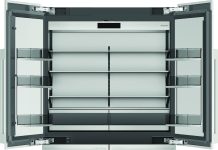 Texas Instruments announced new voice remote control solutions as part of its SimpleLink ultra-low power platform. These were created to help developers easily add ultra-low power Bluetooth low energy, ZigBee RF4CE or multi-standard connectivity to their designs for voice remote controls, TVs, set-top boxes and more. “Developers – explained the company in a press release – can do more with less power by taking advantage of the ultra-low power nature of TI’s new SimpleLink ZigBee RF4CE CC2620 wireless microcontroller (MCU) as well the existing Bluetooth low energy CC2640 wireless MCU or the multi-standard CC2650 solution to create feature-rich remote controls with different technologies. Engineers can reuse their R&D investment for multiple standards and products. Additionally, developers can differentiate products without sacrificing battery life with advanced features such as voice-activated commands and search, gesturing, pointing and more. Texas Instruments makes Bluetooth low energy and RF4CE development for remote controls easier by offering an all-in-one SimpleLink multi-standard CC2650 remote control development kit (CC2650RC) which also connects to the SimpleLink SensorTag ecosystem to expand functionality using DevPack plug-in modules. Using the MSP430FR2633 MCU with CapTIvate technology, developers can also add features like gesture pad, capacitive buttons, sliders and grip detection to their remote designs while operating at less than 4 uA average current. The SimpleLink ultra-low power platform of wireless MCUs has integration at its core with an ultra-low power, multi-standard radio, ARM Cortex-M3 core, direct microphone interface, up to 31 GPIOs, sensor controller and more in a single package from 4×4 to 7×7 mm. With advanced integration and size options, developers can implement RF4CE, Bluetooth low energy or multi-standard connectivity solutions with voice capabilities into a wide range of applications such as wearables, building automation and automotive, as well as in the traditional remote control use cases for TVs and set-top boxes. In addition to these traditional ways of controlling your electronics or TV, this technology can enable end users to use their voice to search for or record their favorite TV show, control lights from across the room or simply input text with their voice”.
Texas Instruments announced new voice remote control solutions as part of its SimpleLink ultra-low power platform. These were created to help developers easily add ultra-low power Bluetooth low energy, ZigBee RF4CE or multi-standard connectivity to their designs for voice remote controls, TVs, set-top boxes and more. “Developers – explained the company in a press release – can do more with less power by taking advantage of the ultra-low power nature of TI’s new SimpleLink ZigBee RF4CE CC2620 wireless microcontroller (MCU) as well the existing Bluetooth low energy CC2640 wireless MCU or the multi-standard CC2650 solution to create feature-rich remote controls with different technologies. Engineers can reuse their R&D investment for multiple standards and products. Additionally, developers can differentiate products without sacrificing battery life with advanced features such as voice-activated commands and search, gesturing, pointing and more. Texas Instruments makes Bluetooth low energy and RF4CE development for remote controls easier by offering an all-in-one SimpleLink multi-standard CC2650 remote control development kit (CC2650RC) which also connects to the SimpleLink SensorTag ecosystem to expand functionality using DevPack plug-in modules. Using the MSP430FR2633 MCU with CapTIvate technology, developers can also add features like gesture pad, capacitive buttons, sliders and grip detection to their remote designs while operating at less than 4 uA average current. The SimpleLink ultra-low power platform of wireless MCUs has integration at its core with an ultra-low power, multi-standard radio, ARM Cortex-M3 core, direct microphone interface, up to 31 GPIOs, sensor controller and more in a single package from 4×4 to 7×7 mm. With advanced integration and size options, developers can implement RF4CE, Bluetooth low energy or multi-standard connectivity solutions with voice capabilities into a wide range of applications such as wearables, building automation and automotive, as well as in the traditional remote control use cases for TVs and set-top boxes. In addition to these traditional ways of controlling your electronics or TV, this technology can enable end users to use their voice to search for or record their favorite TV show, control lights from across the room or simply input text with their voice”.




